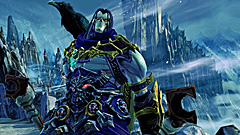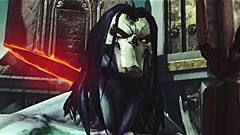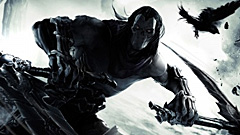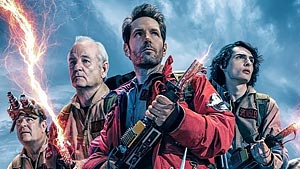August 26, 2012 by Paul Curtin


Taking place simultaneously during the events of the first game, Darksiders II introduces Death, the most feared member of the Four Horsemen of the Apocalypse, who is on an epic journey to prove his brother War’s innocence after he’s been accused of starting the Apocalypse too soon. Sounds pretty simple, but at times the dialog between characters can be a bit too melodramatic when going into details regarding the story’s mythology, which can be confusing when trying to simply figure out how Death’s timeline during the sequel’s 20-30 hours of gameplay fits into the timeline of War’s from the original.
Switching the lead character when so much is at stake was a pretty ballsy move and Vigil should be commended for taking such a risk that is rarely done and doesn’t always work out for the developer. At first, the leaner and meaner Death may seem weaker than his brother War due to the sheer size difference between the two, but it becomes apparent right from the start as Death fights a doppelganger of War that because of his difference in size, Death can move, dodge, and strike a lot more quickly with his dual scythes, making for a generally faster and more stylized pace to the gameplay that pays off and now feels even more like the God of War franchise than ever.
Keeping with the fighting style of the original, Death can still instantly switch between primary and secondary weapons to throw heavy weapons into his dual scythe combos when fighting stronger enemies. Players will also find that blocking has been removed to fit Death’s new fighting style, which focuses more on dodging. Finishers have also been revamped as a chance-on-hit that can be improved by equipped items rather than after an enemy reaches a certain health percentage, and enemies can no longer be mounted and ridden to use as tools against themselves — a feature that was a bit disappointing not to see back in the sequel. However, all the combat changes still offer a nice change of pace that aren’t a massive overhaul but keep the fights from feeling exactly the same as the original.
Death’s increased agility not only allows combat to be at a faster pace but also lets him traverse areas of the game more easily and with far more finesse than his bulkier brother. Where War in the first game could only move across areas like thin platforms using a slow hand-over-hand method, Death can leap across beams in more fluid actions and run up walls to reach higher places to make for enjoyable wall-running sequences à la Prince of Persia. But Death’s not just quicker on his feet and veteran actor Michael Wincott’s quick-lipped responses during interactions with other characters help build more of a personality behind Death as opposed to his stiffer brother War.

Looking for his brother’s absolution, Death’s journey across the varying realms that lie between Heaven and Hell is nothing short of epic as he meets both old and new allies and enemies, all of which are voiced by top-notch actors and set to a powerful and beautiful score. There are frozen tundras where Death encounters frost monsters, cities full of dead skeletons and spirits, and best of all, massive boss fights involving giants, dragons, and other colossal foes that await players at the end of every level. Bosses that have become a signature of the series are back and bigger and better than ever, forcing players to adapt new tactics in order to defeat them and also giving players a desire to progress further through the campaign to see what bigger challenges the game has to offer.
To account for the game’s much larger scale (over twice as big as the original), right from the start of the game Death is able to summon his loyal steed, Despair, unlike the original where players didn’t gain access to a horse mount until halfway into the game. There’s also a new bird companion named Dust who stays by Death’s side throughout the entire campaign and can be called to help Death navigate through the larger and more complex dungeons. Unfortunately, Dust’s help can be hit or miss, and the A.I. seems to get confused at times itself, which only adds to the player’s confusion of which way to go — defeating its purpose as a guide in the first place.
Back at E3, producer Jay Fitloff assured us that the puzzle-to-fighting ratio would be the same as the first game, balancing just enough time spent on puzzles to not frustrate gamers in between hacking and slashing up enemies. While I haven’t played the original in a couple years, Darksiders II seemed like it featured way more in terms of puzzle solving this time around, which isn’t so much of a bad thing since he was right in the sense that I never got bored because of how well the two gameplay mechanics played off of each other. My only gripe with the puzzle systems wasn’t with the actual design but with the quests and reasoning behind why Death needed to do them. Almost every quest deals with Death having to collect three items on some dungeon master’s laundry list that for whatever reason he can’t collect or do himself in order to unlock a door that leads to another locked door, and by the end you’ve done so many collect-or-cleanse-three-item quests that they begin to lose their significance and hurt the main story behind said quests.

Completing quests and killing enemies introduces one of Darksiders II‘s best new features. Transforming the hack-and-slash series into a true RPG, enemies that are killed drop items such as weapons and armor with stats that Death can then equip (if he matches the level requirements). I especially loved the new Possessed Weapons idea where the rarest and most powerful items could have lesser items sacrificed to them, essentially eating the stats of items you have no use for in order for the Possessed Weapons to gain stats and become even more powerful.
What’s impressive about the item system is how simple it all works by instantly showing players if an item is better or worse than what they already have equipped, and giving players the option to instantly equip or add to their inventory. There’s never any time wasted pondering over an inventory full of items that slows down the momentum of the game. The instant popup of new stats is great, but it would have been even better if you could also see a side-by-side comparison of what Death is currently wearing in order to make sure you’re not losing any more critical stats that the new item might exchange for another stat you don’t personally want.
But killing enemies doesn’t just give Death better items, and again like other RPGs, Death can level up by gaining experience and spending skill points in two different skill trees. The Harbinger tree allows for Death to be played like a warrior, while the Necromancer tree switches Death into a spellcaster with minions to fight alongside him. Players can focus on one tree or the other or mix and match by picking only the skills they want — but the trees do branch, so in order to get to some of the more powerful skills, players will have to make some sort of commitment. Rest assured, unlike some other recent singleplayer RPGs, there’s the option to repec in case times throughout the game you want to choose different options after feeling like you’ve made the wrong choice.

Unfortunately, while the gameplay and story are done amazingly well, the game is plagued with glitches that range from minor clipping, camera and sound issues to game-breaking problems with A.I. that can make further progression in the game impossible. There are even constant game freezes that manage to make issues in the recent series of games from Bethesda seem like a rare occurrence. Still, Vigil should be commended for their save system that makes up for the freezes by constantly saving and instantly respawning Death exactly where he was before the game froze, even after having to restart the entire system. Although the freezing was the worst I’ve ever seen in a game, the save system and seamless transition back into the game was done better than anything I’ve seen before.
My worst experience however was something that should have never made it out of Vigil’s testing stages and dealt with the use of souls that must be guided and used to turn levers that Death himself couldn’t get to in a certain dungeon. The souls kept glitching into the levers after pulling them and causing the gate lowering cutscene to not play, leaving me just standing there with no option B for getting to where I needed to be. Other times dealing with the same glitch I would tell the souls to move, and they would just stand there doing nothing. I spent a solid hour trying to get the game to work and eventually after the third time of fast-traveling out and back into the dungeon, the problem fixed itself and I was able to continue. I wasn’t the only person who experienced this problem after doing a bit of Google’n and found that I might have even been lucky and dodged a couple other rage-inducing and game-breaking issues.
The Verdict
Darksiders II overall is a home run that delivers everything you could want in a sequel to an open-world game with a massive amount of content between the game’s main story, side-quests, Crucible arena challenge mode, and New Game+ mode that allows players to go back after beating the game with all their previous stats and hunt for even rarer items. However, the numerous glitches take a taxing toll on the immersion, making you question whether the game should have been delayed a couple more months in order to work out some more of the kinks.
The story also starts out as if there could be some sort of confrontation between the two brothers: Death is teased with the idea of whether he’s doing the right thing by trying to save War, but this is never alluded to again after the start and could have made for a much stronger narrative and ending conflict, especially considering how weak the final boss is. Like the original, Darksiders II sets up future games involving the Horsemen and based on what we’ve seen so far, we can’t wait to see the return of the Horsemen yet again, but hopefully next time Vigil will bring a little less bugs and glitches with them and the success of Darksiders II will help keep THQ afloat until the next Apocalypse. Darksiders II gets 4 out of 5 stars (Great).
The Pros
- New lead character transition works flawlessly
- Top-notch score and dialog from each character’s voice actor
- Amazing boss fights on epic scales offer unique challenges
- New RPG mechanics add more depth to the gameplay
- Great mix of combat and puzzles keep gameplay refreshing
- Side quests, New Game+ mode, Crucible arena, and loot upgrades offer extended play
The Cons
- Game constantly freezes and has some very serious glitches
- Quests and dungeons become too repetitive
- Story can at times be a bit confusing














